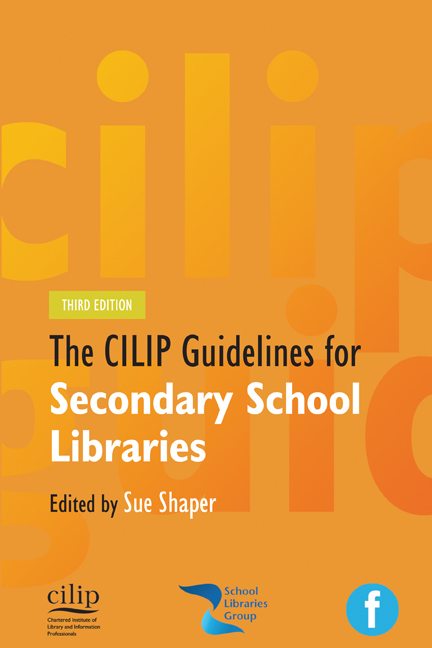Book contents
- Frontmatter
- Contents
- Foreword
- Key recommendations
- Introduction
- Notes
- Abbreviations
- 1 The school librarian and learning: CILIP's vision
- 2 Staffing and management
- 3 Policies and planning
- 4 The library environment
- 5 Management of learning resources
- 6 Information literacy
- 7 Developing students as readers
- 8 Marketing, promotion and advocacy
- 9 Evaluation
- 10 Partnerships
- References
- Appendices
- Index
4 - The library environment
Published online by Cambridge University Press: 08 June 2018
- Frontmatter
- Contents
- Foreword
- Key recommendations
- Introduction
- Notes
- Abbreviations
- 1 The school librarian and learning: CILIP's vision
- 2 Staffing and management
- 3 Policies and planning
- 4 The library environment
- 5 Management of learning resources
- 6 Information literacy
- 7 Developing students as readers
- 8 Marketing, promotion and advocacy
- 9 Evaluation
- 10 Partnerships
- References
- Appendices
- Index
Summary
CILIP recommends that the environment of the school library supports its role as a whole-school learning resource. This means that:
• the library is a central resource, accessible and welcoming to all members of the school community
• the library accommodates at least one class
• the library is designed for flexibility to allow a variety of functions
• the design of the library enhances the users’ experience and encourages a positive attitude to learning
• the organization of the library is obvious to users of all abilities.
Introduction
While the modern school library extends beyond its four walls, its physical design and layout will set the tone for the environment and ethos of the facility and contribute to the positive experiences of all users: students, staff and the wider school community. As one of the major learning spaces within a school, it must meet the needs of all user groups. The implications of the Equality Act 2010 have been considered throughout this chapter (The Stationery Office, 2010). The following areas, all of which need consideration when planning and managing the library facility, will be looked at:
• location
• size
• design
• use
• signage
• display.
The checklist in Appendix 10 addresses further practical considerations. It is intended to be a tool to help librarians identify the strengths and weaknesses in their existing facilities and plan for improvements. Regardless of the existing space and position of the school library, the majority of general principles outlined here can be applied and are certainly important when planning any new development. School library services, where available, provide an independent, unbiased source of advice and support to the librarian and the school in developing effective and well planned library facilities, and should be consulted in any new development.
Location
The location of the library has an impact on its use. Where new developments are planned or where relocation opportunities arise, the following principles should be taken into account:
The library should be on one floor only, preferably the ground floor, to enable good access for disabled users and easy delivery of goods. Where dual school/community use is planned, especially out of school hours, a ground floor location close to an external entrance is essential for security reasons.
- Type
- Chapter
- Information
- CILIP Guidelines for Secondary School Libraries , pp. 25 - 34Publisher: FacetPrint publication year: 2014



